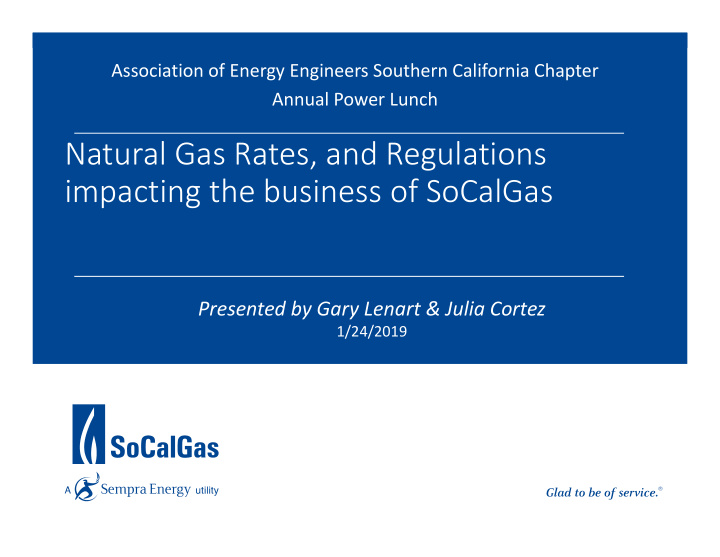



Association of Energy Engineers Southern California Chapter Annual Power Lunch Natural Gas Rates, and Regulations impacting the business of SoCalGas Presented by Gary Lenart & Julia Cortez 1/24/2019 2/4/2019
Topics to Cover • Transportation & Surcharge Rate Changes • Greenhouse Gas Cap and Trade Allowance Prices • Components of your Natural Gas Bill • Status of Natural Gas Prices • Natural Gas Supply • Renewable Natural Gas • Proposed core rate for small electric generation
3
Chang Changes in in Tr Transportation Ra Rates & Sur Surchar harges es • Costs related to the State’s Greenhouse Gas program, referred to as the “Greenhouse Gas Cap and Trade program” will be included in transportation rates at approximately 4.7 ¢/therm • Under collected costs from the prior year were authorized in Regulatory Account Update filing (Advice Letter 5368 filed in November 2018). • Higher funding of Public Purpose Programs was authorized in the Public Purpose Program Surcharge filing (Advice Letter 5374 filed in November, 2018) due to an increase in the Energy Efficiency Incentive Programs and the Low ‐ Income Programs.
Cap Cap and and Tr Trade Al Allo lowance nce Pr Prices
6
St Status us of of Na Natur tural Gas Gas Pr Prices
Na Natur tural Gas Gas Supply Supply
Western US Supplies & Pipelines
Na Natur tural Gas Gas Supply Supply • Los Angeles/Orange County are at the center of the SoCalGas transmission system. • Access of supplies through • 14 receipt points into the SoCalGas system • Includes Local and Off Shore production • Includes access to Liquefied Natural Gas (LNG) input Terminal • 4 storage fields • Aliso Canyon at partial operations.
Futu Future Supply Supply Sour Source ce Re Renewa wable Na Natur tural Gas Gas aka Bio ak Bio ‐ Met Methane • Decomposition of organic waste results in BIOGAS • BIOGAS is composed primarily of C02 and Methane • Historically, this has been vented into the atmosphere • Methane has a greenhouse gas effect over 20x that of C02 • Capturing BIOGAS and removing the C02 results in a pipeline quality gas called BIO ‐ METHANE • Chemically the same as regular natural gas • Burning BIO ‐ METHANE from dairy waste can result in a NEGATIVE greenhouse gas impact • Due to eliminating all of the methane that would normally occurr
Convert waste into biogas from dairies, farms using anaerobic digestion and landfills CH 4 process the biogas to make it pipeline-ready (biomethane) put the biomethane into the pipeline for future use 12 Navigant Consulting, “Gas Strategies for a Low-Carbon California Future,” 2018 Bioenergy Association of California, ”Decarbonizing The Gas Sector: Why California Needs A Renewable Gas Standard,” 2014.
Futu Future Supply Supply Sour Source ce Re Renewa wable Na Natur tural Gas Gas ak aka Bio Bio ‐ Met Methane • 2 Bio ‐ Methane producers have interconnected • 1 more is near completion • Several more under engineering study • 3 recently approved as part of a pilot program for dairy cluster
Pr Proposed co core ra rate fo for sm small all electric electric ge generation on • A cost based rate determined by the usage characteristics of small EG customers • High usage factor compared to average core C&I customer results in lower effective rate • Current tariff only allows core service under the existing core C&I rate which is not based on the costs incurred by a small EG customer • Allows core gas supplies unlike noncore service • If approved will be implemented 1/1/2020 • Filed as part of transportation rates in the Triennial cost allocation proceeding application A.18 ‐ 07 ‐ 024
15
Ques Questions? ons?
SoCalGas SoCalGas Tr Transportation Ra Rates inclusion of Cap and Trade costs and Annual Regulatory Account Balance Update $/therm
Public ublic Pu Purpose Surc rcharge rge Energy efficiency programs and Low Income Assistance $/therm
Futu Future Supply Supply Sour Source ce Re Renewa wable Na Natur tural Gas Gas ak aka Bio Bio ‐ Met Methane • Federal and State programs are encouraging the use of BIO ‐ METHANE as a transportation fuel (ie NGVs and natural gas buses) • Federal Program ‐ Renewable Identification Number & Renewable Fuel Standards (RIN & RFS) • State Program – Low Carbon Fuel Standard LCFS • Fuel suppliers (ie. refineries) are required to reduce the “CARBON INTENSITY” of their products. • May accomplish by purchasing carbon offsets (ie RIN and LCFS Credits) • A Renewable Natural Gas producer will create carbon offsets (ie RIN & LCFS credits) when they sell RNG to a transportation end ‐ use
20
Recommend
More recommend